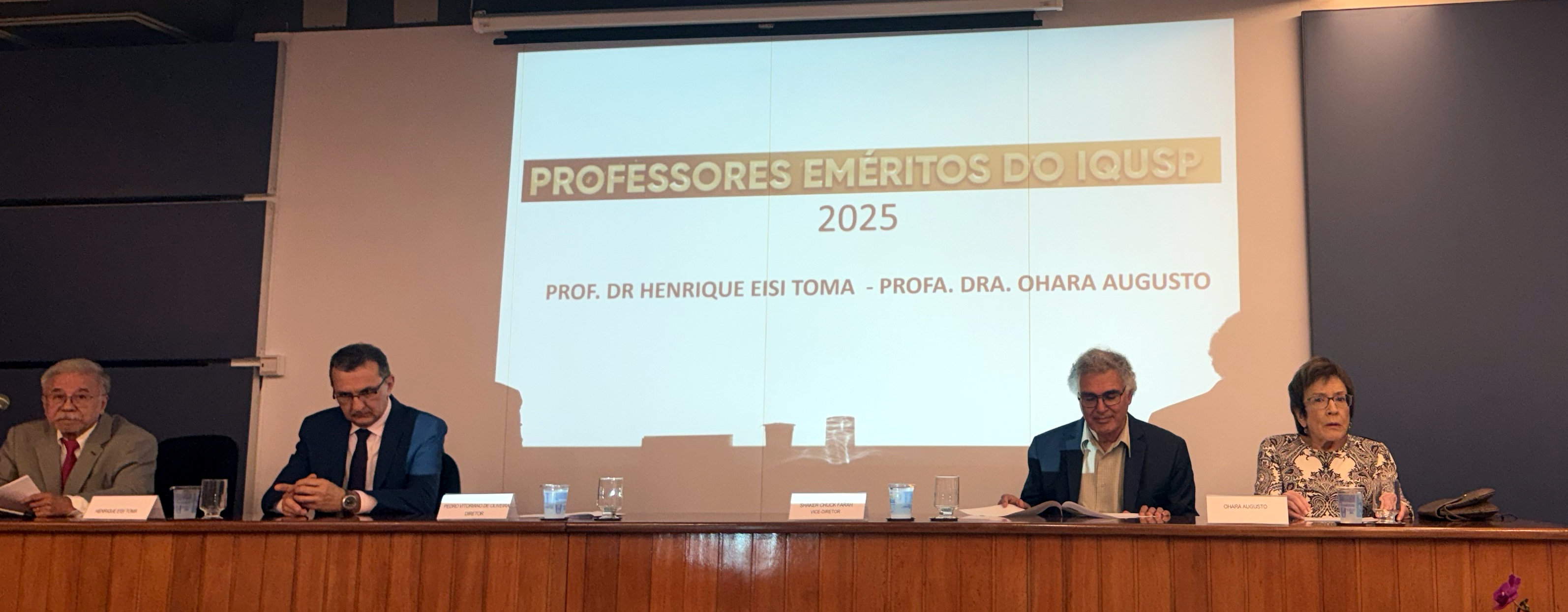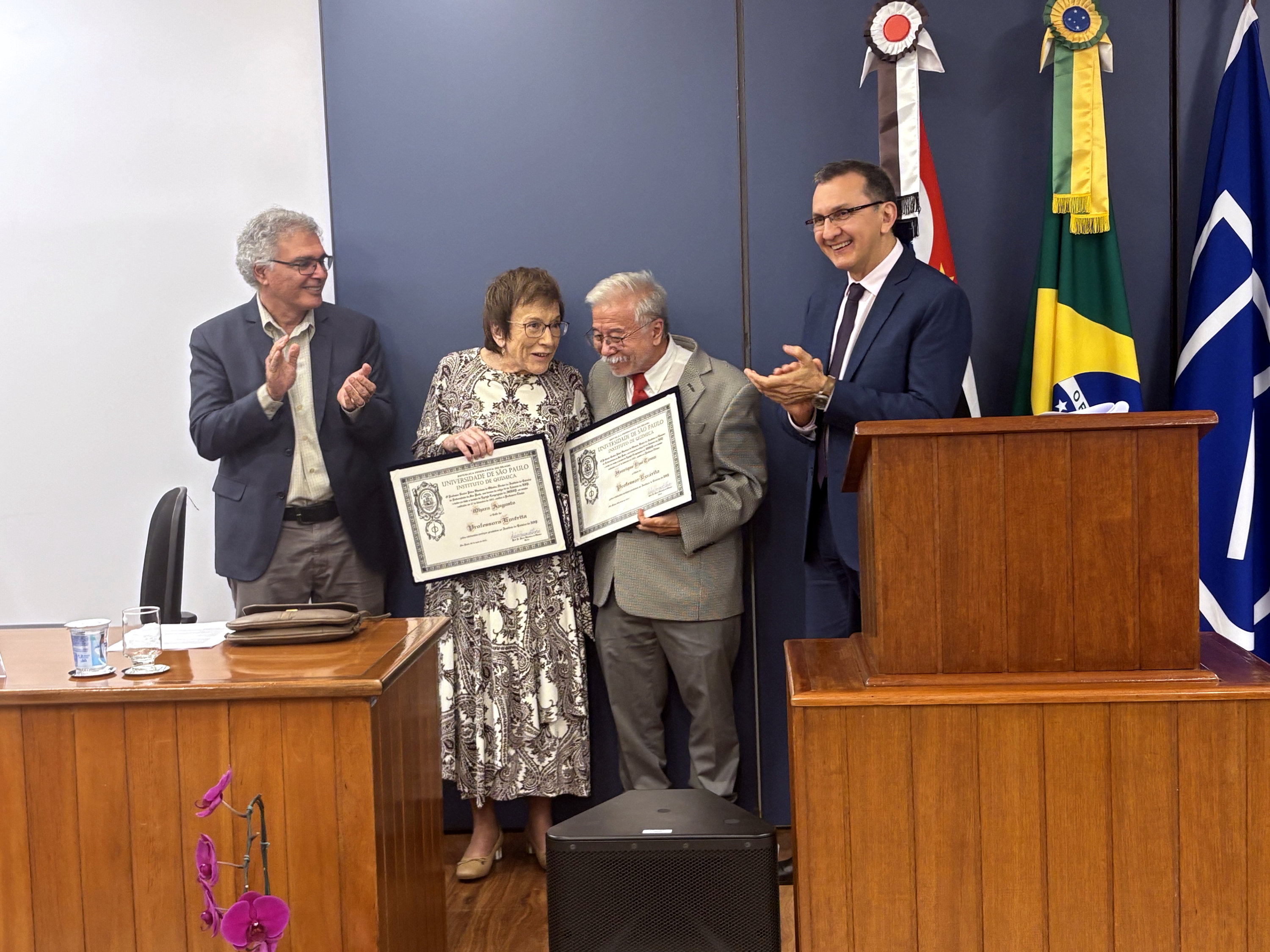Ohara Augusto Named Professor Emeritus by the Instituto de Química at USP
Professor Ohara Augusto, a reference in the field of free radical and oxidant biochemistry, and Professor Henrique Eisi Toma, one of the most prominent figures in Brazilian Chemistry, were awarded the title of Professor Emeritus by the Instituto de Química of the Universidade de São Paulo (IQ-USP). The ceremony on May 8 in the IQ-USP auditorium celebrated the outstanding scientific legacies and their enduring contributions to academic training and scientific progress in Brazil.
During the ceremony, the director of IQ-USP, Pedro Vitoriano de Oliveira, highlighted the symbolic nature of the tribute to two key figures of the Institute of Chemistry. “Professor Henrique is memory and history. I believe everything he shows us and creates is part of the Institute’s legacy, and without history, we don’t live, we fade away. As for Professor Ohara, she has an extraordinary ability to bring people together to work on essential and highly relevant research topics. In recent times, from what I’ve seen, her initiative has led to the creation of collaborative projects that have brought research groups together, strengthening not only the Institute, but the groups themselves.“
In his speech, Henrique Toma emphasized the importance of experimental chemistry education, sharing his experience in a collaborative project with other scientists to develop science kits—an initiative interrupted due to lack of political support. He highlighted, in particular, the use of chemistry kits during the pandemic, a project published in the Journal of Chemical Education in 2021.
Ohara Augusto emphasized the significance of being the first woman to receive the title of Professor Emerita at the Instituto de Química. “We are a bit behind, but I am fully convinced that I am just the first in line. Very soon, many of my female colleagues will be here with us,” she said.
The ceremony concluded with a performance by Duo Pujol, composed of flutist Fabio Ferreira and guitarist Lucas Vieira. The repertoire included works by Heitor Villa-Lobos, Astor Piazzolla, and Jacob do Bandolim.
A senior full professor in the Departamento de Bioquímica at IQ-USP and the director of the Research Center for Redox Processes in Biomedicine - RIDC Redoxoma-, Ohara Augusto has built a career defined by groundbreaking scientific discoveries and a profound commitment to mentoring future generations of researchers. Her scientific path has been marked by pioneering studies that have reshaped our understanding of oxidative processes.
Pioneering Research on Free Radicals
After earning her degree in Chemistry from USP, Professor Augusto earned her PhD in Biochemistry under the supervision of Professor Giuseppe Cilento. She began her postgraduate studies in 1972, when the scientific community was just beginning to unravel the dual nature of molecular oxygen: essential for life, yet capable of generating toxic reactive species.
From the outset, her research has centered on elucidating the diverse roles of these chemical species in health and disease. During her doctoral work, she contributed to the discovery that reductants, paradoxically, could produce oxidants in vivo. Seeking to improve techniques for detecting free radicals, she completed postdoctoral research at the Universities of California, Berkeley, and San Francisco, specializing in electron paramagnetic resonance (EPR) spectroscopy, an essential method for definitively identifying free radicals.
Upon returning to Brazil, she partnered with Professor Shirley Schreier to establish the EPR Laboratory at IQ-USP. The lab became a national hub for redox research, welcoming scientists from across Brazil and Latin America. In this laboratory, Ohara’s group continued to research mechanisms of drug toxicity, demonstrated free radical damage to DNA and RNA, and characterized oxidizing species such as the carbonate radical. This latter work, done in collaboration with Uruguayan researcher Rafael Radi, earned her the International EPR Society’s Biology and Medicine Medal in 2002.
As nitric oxide was discovered to be a cellular messenger and the field of redox biology expanded, Professor Augusto helped solidify the view that free radicals could have both harmful and essential physiological roles. She advanced this perspective in her textbook Radicais Livres: Bons, Maus e Naturais (Free Radicals: Good, Bad, and Natural) (Oficina de Textos, 2006), aiming to inspire the next generation of Brazilian scientists.
Her recent research has focused on the biological roles of oxidants derived from the bicarbonate buffer, the principal pH regulator in mammals. Investigating the production of carbonate radicals by the human enzyme superoxide dismutase 1 (hSOD1), her group demonstrated that these radicals can trigger protein aggregation, a process associated with neurodegenerative diseases and cataracts. Additionally, her latest findings suggest that peroxymonocarbonate, another CO₂-derived oxidant, may play a role in cellular signaling—a line of inquiry especially relevant in the context of rising atmospheric CO₂ levels.
Throughout her distinguished career, Professor Augusto has received numerous accolades, including the Lifetime Achievement Award from the Society for Redox Biology & Medicine (2022), the Biology Medal from the International EPR Society (2002), and the Brazilian Women in Chemistry Award from the American Chemical Society and the Brazilian Chemical Society (2022). She is also a member of several prestigious scientific organizations, including the Brazilian Academy of Sciences, the São Paulo State Academy of Sciences, and TWAS – The World Academy of Sciences.
Beyond her research, Professor Augusto also played a key role in building collaborative scientific networks.
Redoxoma
In collaboration with other researchers, Ohara Augusto was one of the founding members of the Redoxoma network, established in 2006 through a Millennium Project funded by CNPq. According to her, the network’s conception was inspired by earlier initiatives, such as thematic projects led by prominent Brazilian scientists in the redox field — among them Rogério Meneghini, Anibal Vercesi, and Etelvino Bechara — who, even before the Millennium Project, were already promoting significant advances and fostering collaboration among researchers in the area.
Redoxoma continued in 2010 as a National Institute of Science and Technology (INCT), also supported by CNPq, and culminated in 2013 with the creation of the Research Center for Redox Processes in Biomedicine - RIDC Redoxoma, funded by FAPESP.
“One of my greatest satisfactions was Redoxoma because the network enhanced scientific interactions and raised the quality of research among all participants. It also encouraged researchers to engage more in educational and science communication activities, as well as in innovation and technology transfer. The CEPID Redoxoma project, coordinated by me and Francisco Laurindo, will conclude in August 2026. However, the group remains strong and cohesive, with new leadership and initiatives, such as the establishment of a CEPIX at USP, led by researchers Mauricio Baptista and Alicia Kowaltowski,” Ohara said.
